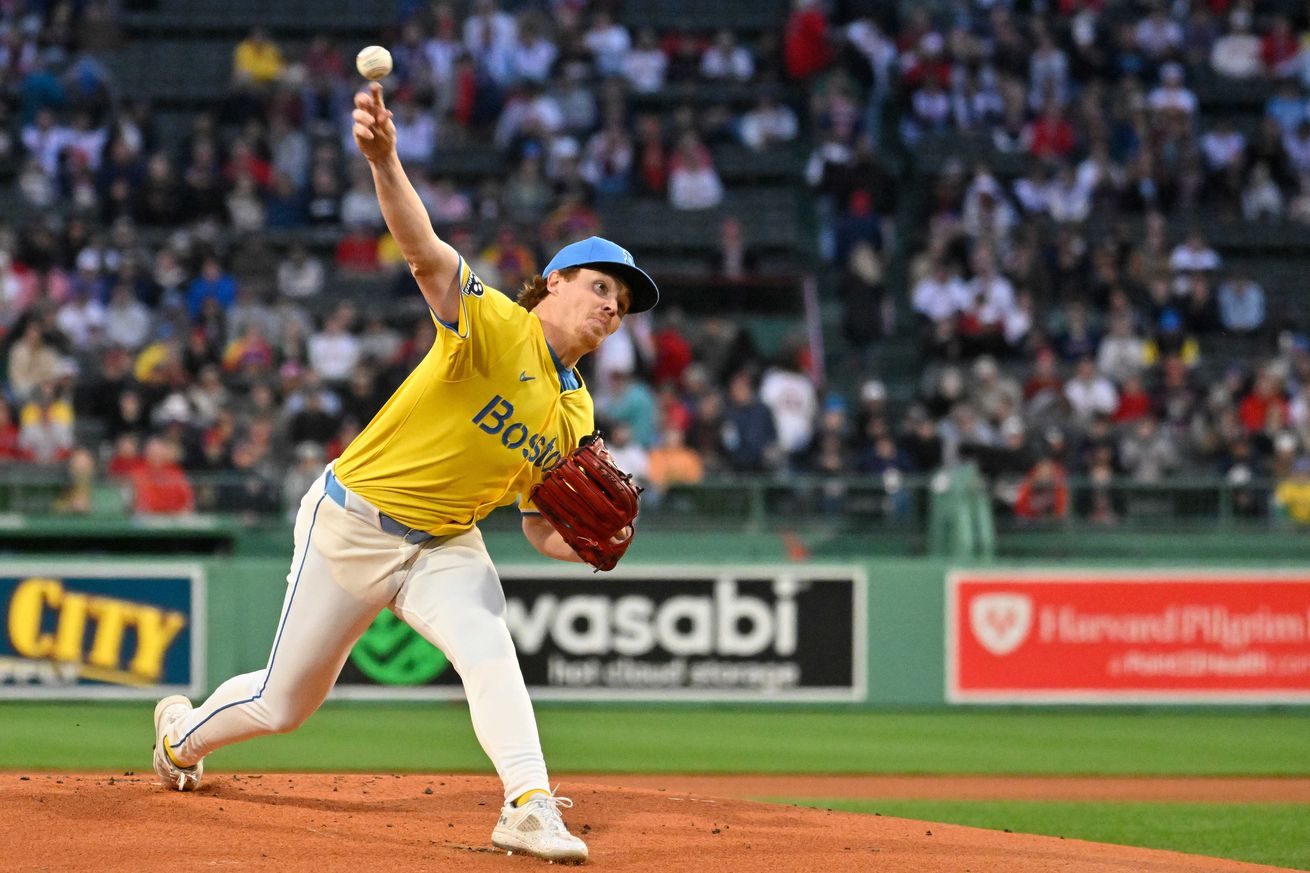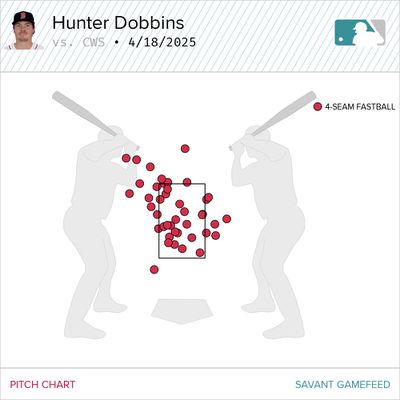
Let’s not get too excited just yet
Hunter Dobbins is the latest and greatest Red Sox prospect in the new and improved pitching pipeline. He’s made two spot-starts thus far, pitching eleven innings and allowing just three runs. Most recently, he threw six innings of one-run baseball against the White Sox on Friday night. I’m not super tuned into the prospect scene, so I wanted to look at how Dobbins looked in a major league setting.
In his start against the White Sox, Dobbins used his fastball 53% of the time. His command of the pitch was only okay. If you look at the pitch chart, there’s a lot over the middle of the plate.

Dobbins only managed to generate two whiffs on 42 fastballs. At the same time, the strike rate on the pitch was over 70%. Obviously, missing bats is important if he’s going to use the pitch so frequently. At the same time, I wonder if there’s something more to the shape of the pitch.
Really interested in Hunter Dobbins’ fastball. The horizontal movement is close to the zero line. This one even has two inches of cut. I’d imagine it’s unexpected from his arm angle, which could lead to mis-hits and foul balls. pic.twitter.com/YNhevmSwAs
— Jake (@Jake3Roy) April 19, 2025
Dobbins throws from a very vertical arm angle, which often causes increased vertical movement and less arm-side run. Dobbins’ fastball has minimal arm-side movement at all, to the point where I wonder if the pitch appears as if it’s cutting. This unexpected movement would likely lead to foul balls and weak contact such as this:
The shape of the pitch should provide Dobbins some relief, but a better lineup than the White Sox may find success against some of those in-zone fastballs. Going forward, I’d like to see Dobbins throw to the top of the zone more consistently. If he can, the whiffs will likely follow.
Moving past the fastball, I was impressed by Dobbins in other areas. He located his sweeper and slider consistently to the glove side against right-handed hitters. His splinker was mostly down and arm-side against lefties. Over his two appearances, each off-speed pitch has shown some whiff-generating ability. His deep arsenal also allows him to use the entire plate and adjust from at-bat to at-bat.
Let’s look at an at-bat or two to see Dobbins in action, starting with Andrew Vaughn in the second inning.
Dobbins starts the matchup with a fastball. He misses his spot, but hits the inside edge for called strike one. Good miss.
At 0-1 Dobbins throws a slider that once again misses, but Vaughn swings on top of it and fouls it into his foot. At 0-2, Dobbins should look to throw something off the plate to try to induce a whiff.
It’s a sweeper that’s too far off the plate. Usually, you can learn something with a take, but this pitch was too uncompetitive to glean too much information from.
Dobbins throws another sweeper; this time, Vaughn tracks it the entire way. At 2-2, Dobbins can go a few different directions. He could throw a high fastball to change speeds. Oftentimes, after a hitter spits on a good breaking ball, they feel as though they’ve “earned” a fastball, making another breaking ball a good option. Dobbins also has his curveball and could throw one in the dirt.
Dobbins goes back to the sweeper, Vaughn is out in front, and Dobbins gets the strikeout. I really like how Dobbins attacked from 1-2 onwards here. First, he was able to adjust on the fly and throw a good breaking ball at 1-2 after wasting one on the pitch before. After that, he showed confidence in his sweeper by tripling up on it. It’s a very mature approach from a young pitcher in sticking to his game plan and executing after two good takes by Vaughn. Great stuff.
Let’s jump ahead to the fifth inning with a runner on third and two outs. Michael A. Taylor is at the plate for his second at-bat. Taylor flew out on the eighth pitch of his first at-bat.
First pitch, slider below the zone. Taylor is looking for a fastball and is totally fooled, swinging and missing for strike one.
Here’s a fastball that Taylor can’t handle. It’s just 94 MPH and right in the hitting zone. Taylor whiffs, but this is a mistake from Dobbins at 0-1. After seeing Taylor be late against 94 MPH, I’d go back to the fastball.
It is the fastball, and Dobbins once again misses his spot. Fortunately, Taylor appears to be expecting something off-speed and takes this for called strike three. This one isn’t as bad of a miss as the previous, but it’s still not a great 0-2 pitch.
I wanted to highlight this at-bat not to take away from Dobbins — he made the pitches he needed to — but to show how the box score doesn’t exactly tell the full story. Dobbins does a great job making the pitches he needs to in this situation. Going forward, this may not be enough to get the job done, though. I’ll admit, I’ve rewatched this start twice now, and on a second viewing, I think my initial impression was a bit of an overreaction. Still, Dobbins will need to clean up the mistakes to succeed in future starts.
Dobbins is far from a finished product. He’s only made two starts in the majors. He started throwing his splinker last season, which speaks to his ability to learn as a pitcher. He’s a future big league pitcher; I have little doubt about that. All I’m asking is that if Tanner Houck continues to struggle or Brayan Bello can’t find his footing right away, consider pumping the brakes before you light the Dobbins signal.